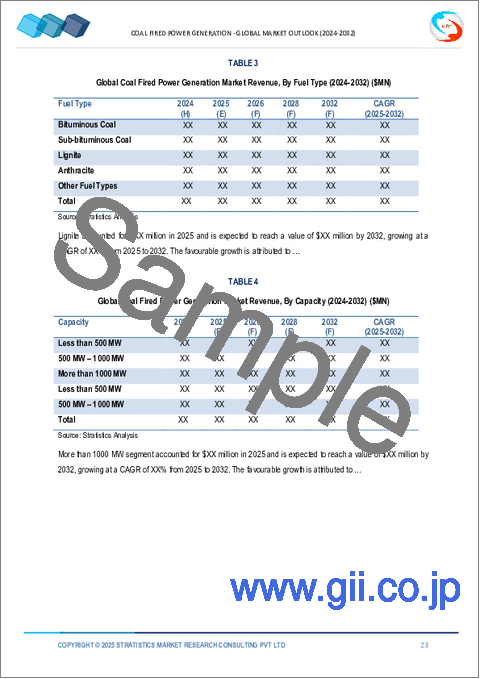|
|
市場調査レポート
商品コード
1787920
石炭火力発電市場、2032年までの予測: コンポーネント別、発電所タイプ別、燃料タイプ別、容量別、技術別、用途別、地域別の世界分析Coal Fired Power Generation Market Forecasts to 2032 - Global Analysis By Component, Plant Type, Fuel Type, Capacity, Technology, Application and By Geography |
||||||
カスタマイズ可能
|
|||||||
| 石炭火力発電市場、2032年までの予測: コンポーネント別、発電所タイプ別、燃料タイプ別、容量別、技術別、用途別、地域別の世界分析 |
|
出版日: 2025年08月07日
発行: Stratistics Market Research Consulting
ページ情報: 英文 200+ Pages
納期: 2~3営業日
|
全表示
- 概要
- 図表
- 目次
Stratistics MRCによると、世界の石炭火力発電市場は2025年に1,085億米ドルを占め、2032年には1,528億米ドルに達すると予測され、予測期間中のCAGRは5%です。
火力発電所で石炭を燃やして発電するプロセスは、石炭火力発電として知られています。このプロセスは、炉の中で石炭を燃やし、ボイラーで水を加熱することによって高圧蒸気を発生させる。この蒸気で発電機に取り付けられたタービンを回し、熱エネルギーを電気エネルギーに変換します。石炭は豊富で価格も手ごろなため、石炭火力発電所は特に開発途上国で多く採用されています。しかし、石炭火力発電所は、温室効果ガスの排出や大気汚染の主な原因となっており、国際的なエネルギー・環境問題の議論の中で注目されています。
新興国における高い電力需要
世界の急速な都市化と工業化によって、信頼できる広範な電力供給への需要が高まっています。この増大するニーズを満たす、信頼性が高く手頃な方法は、石炭火力発電施設です。石炭は広く利用可能で、インフラも整備されているため、多くの発展途上国でいまだに使用されています。代替エネルギー源が限られていることも、石炭火力発電の地位を支えています。そのため、石炭火力設備への投資は、これらの地域では依然として増加しています。
厳しい環境規制と排出基準
スクラバーや炭素回収システムは、発電所が要件を満たすために購入しなければならない高価な汚染防止技術です。石炭系エネルギーの経済性と魅力は、こうした追加コストによって低下します。石炭の使用をさらに抑制するため、政府は過度の排出に対して罰金や手数料を課すこともあります。規制の強化はまた、石炭火力発電所の新規認可を制限し、市場の拡大を遅らせています。よりクリーンな代替エネルギーが普及するにつれ、石炭は存続可能なエネルギー源であり続けるために苦闘しています。
炭素回収・貯留(CCS)の技術的進歩
新しいCCS技術により、排ガスからCO2をより効果的に回収することで、石炭火力発電所は環境的に実現可能なものになりました。こうした開発により、工場は操業を停止することなく、厳しい排出基準を遵守することができます。CCSの統合が改善されたことで、工場全体の効率が向上し、操業コストが削減されます。さらに、各国政府はCCSの開発を支援するため、財政的・政策的なインセンティブを提供しています。従って、炭素を懸念するエネルギー情勢において、CCS技術は石炭火力発電所の運転寿命と重要性を延長しています。
再生可能エネルギーとの競合激化
太陽光発電、風力発電、水力発電などの代替エネルギーは、より安価でクリーンなものになりつつあります。炭素税、規制、補助金は、世界中の政府が再生可能エネルギーを奨励する方法の一部です。石炭ベースのエネルギーに対する需要が変化した結果、石炭発電所は経済的に成り立たなくなっています。再生可能エネルギーの信頼性は、エネルギー貯蔵の技術開発によってさらに強化されます。その結果、市場の拡大は、石炭インフラへの投資の継続的な減少によって影響を受ける。
COVID-19の影響
COVID-19の大流行は石炭火力発電市場を大きく混乱させ、産業活動の停滞や全国的な操業停止による電力需要の減少につながりました。多くの発電所が操業上の制約、労働力不足、物流の課題に直面し、その結果、石炭の消費量が減少しました。各国が復興計画で再生可能エネルギー・プロジェクトを優先したため、石炭ベースのインフラへの投資は減少しました。さらに、世界・サプライ・チェーンの不安定さが石炭の輸送と入手に影響を与えました。また、パンデミックは、特にクリーンな代替エネルギーにシフトしている地域において、旧式で効率の低い石炭プラントの退役を加速させました。これは市場に長期的な影響を与えました。
予測期間中、発電機セグメントが最大になる見込み
発電機セグメントは、石炭燃焼による安定した効率的な電力出力が確保されるため、予測期間中最大の市場シェアを占めると予想されます。先進的な発電機技術は、プラント全体の効率を高め、運用コストを削減し、エネルギーの信頼性を高める。大容量発電機は、特に工業地帯や都市部における電力需要の増加に対応するために不可欠です。発電機の設計における絶え間ない技術革新は、熱効率の向上と低排出ガスに貢献しています。新興国市場がエネルギー・インフラを拡大する中、堅牢な石炭焚き発電機への需要が引き続き市場の成長を牽引しています。
予測期間中、住宅用セグメントが最も高いCAGRが見込まれる
予測期間中、都市人口の増加による電力需要の継続的な増加により、住宅セグメントが最も高い成長率を示すと予測されます。多くの新興諸国は、家庭のエネルギー需要を満たすために、特に再生可能エネルギーへのアクセスが限られている地域では、いまだに石炭ベースの電力に大きく依存しています。石炭火力発電の手頃な価格と確立されたインフラが、住宅消費に適した選択肢となっています。さらに、住宅の暖房と冷房の季節的なピークが、石炭火力発電の安定した利用をさらに後押ししています。この安定した需要が石炭火力発電所の維持に役立ち、市場の成長を支えています。
最大のシェアを占める地域:
予測期間中、アジア太平洋地域は、特に中国、インド、インドネシアで電力用石炭への依存度が高いため、最大の市場シェアを占めると予想されます。急速な都市化、産業成長、電力需要の増加は、再生可能エネルギーの採用が増加しているにもかかわらず、石炭の役割を維持しています。各国政府は、経済と環境の目標を両立させるため、超臨界圧ボイラーや超々臨界圧ボイラーのような、よりクリーンな石炭技術への投資を続けています。しかし、国際的な気候協定や地域的な公害問題からの圧力の高まりは、この地域全体で再生可能エネルギーやハイブリッド・システムへの漸進的な移行を促しています。
CAGRが最も高い地域:
予測期間中、北米地域が最も高いCAGRを示すと予測されます。これは、同地域がよりクリーンなエネルギー源へ積極的にシフトしているためです。米国とカナダは、厳しい環境規制、安価な天然ガス、再生可能エネルギーへの投資により、多数の石炭発電所を閉鎖しました。炭素回収機能を備えた稼働中の発電所もいくつかあるが、石炭消費量全体は大幅に減少しています。公共政策、企業の持続可能性目標、投資家の嗜好の変化は、石炭発電をさらに抑制しています。この地域における石炭市場の将来は、主に廃止措置と石炭インフラの再利用に結びついています。
無料カスタマイズサービス:
本レポートをご購読のお客様は、以下の無料カスタマイズオプションのいずれかをご利用いただけます:
- 企業プロファイル
- 追加市場プレーヤーの包括的プロファイリング(3社まで)
- 主要企業のSWOT分析(3社まで)
- 地域セグメンテーション
- 顧客の関心に応じた主要国の市場推計・予測・CAGR(注:フィージビリティチェックによる)
- 競合ベンチマーキング
- 製品ポートフォリオ、地理的プレゼンス、戦略的提携に基づく主要企業のベンチマーキング
目次
第1章 エグゼクティブサマリー
第2章 序文
- 概要
- ステークホルダー
- 調査範囲
- 調査手法
- データマイニング
- データ分析
- データ検証
- 調査アプローチ
- 調査資料
- 1次調査資料
- 2次調査情報源
- 前提条件
第3章 市場動向分析
- 促進要因
- 抑制要因
- 機会
- 脅威
- 技術分析
- 用途分析
- 新興市場
- COVID-19の影響
第4章 ポーターのファイブフォース分析
- 供給企業の交渉力
- 買い手の交渉力
- 代替品の脅威
- 新規参入業者の脅威
- 競争企業間の敵対関係
第5章 世界の石炭火力発電市場:コンポーネント別
- ボイラー
- タービン
- 発電機
- 空気質制御システム
- 制御システム
- 補助機器
- その他のコンポーネント
第6章 世界の石炭火力発電市場:発電所タイプ別
- ベースロード発電所
- ピーク負荷発電所
第7章 世界の石炭火力発電市場:燃料タイプ別
- 瀝青炭
- 亜瀝青炭
- 亜炭
- 無煙炭
- その他の燃料タイプ
第8章 世界の石炭火力発電市場:容量別
- 500MW未満
- 500MW~1000MW
- 1000MW以上
第9章 世界の石炭火力発電市場:技術別
- 微粉炭燃焼(PCC)
- 流動床燃焼(FBC)
- ガス化複合発電(IGCC)
第10章 世界の石炭火力発電市場:用途別
- 住宅
- 商業
- 産業
- ユーティリティ
- その他の用途
第11章 世界の石炭火力発電市場:地域別
- 北米
- 米国
- カナダ
- メキシコ
- 欧州
- ドイツ
- 英国
- イタリア
- フランス
- スペイン
- その他欧州
- アジア太平洋
- 日本
- 中国
- インド
- オーストラリア
- ニュージーランド
- 韓国
- その他アジア太平洋地域
- 南米
- アルゼンチン
- ブラジル
- チリ
- その他南米
- 中東・アフリカ
- サウジアラビア
- アラブ首長国連邦
- カタール
- 南アフリカ
- その他中東とアフリカ
第12章 主な発展
- 契約、パートナーシップ、コラボレーション、ジョイントベンチャー
- 買収と合併
- 新製品発売
- 事業拡大
- その他の主要戦略
第13章 企業プロファイリング
- General Electric Company
- Siemens Energy AG
- Mitsubishi Heavy Industries, Ltd.
- Babcock & Wilcox Enterprises, Inc.
- Doosan Enerbility Co., Ltd.
- Toshiba Corporation
- Harbin Electric Corporation
- Shanghai Electric Group Co., Ltd.
- Dongfang Electric Corporation
- Larsen & Toubro Limited
- China Energy Engineering Corporation
- Thermax Limited
- BWX Technologies, Inc.
- MAN Energy Solutions SE
- Alstom SA
- Hitachi, Ltd.
List of Tables
- Table 1 Global Coal Fired Power Generation Market Outlook, By Region (2024-2032) ($MN)
- Table 2 Global Coal Fired Power Generation Market Outlook, By Component (2024-2032) ($MN)
- Table 3 Global Coal Fired Power Generation Market Outlook, By Boilers (2024-2032) ($MN)
- Table 4 Global Coal Fired Power Generation Market Outlook, By Turbines (2024-2032) ($MN)
- Table 5 Global Coal Fired Power Generation Market Outlook, By Generators (2024-2032) ($MN)
- Table 6 Global Coal Fired Power Generation Market Outlook, By Air Quality Control Systems (2024-2032) ($MN)
- Table 7 Global Coal Fired Power Generation Market Outlook, By Control Systems (2024-2032) ($MN)
- Table 8 Global Coal Fired Power Generation Market Outlook, By Auxiliary Equipment (2024-2032) ($MN)
- Table 9 Global Coal Fired Power Generation Market Outlook, By Other Components (2024-2032) ($MN)
- Table 10 Global Coal Fired Power Generation Market Outlook, By Plant Type (2024-2032) ($MN)
- Table 11 Global Coal Fired Power Generation Market Outlook, By Base Load Plants (2024-2032) ($MN)
- Table 12 Global Coal Fired Power Generation Market Outlook, By Peak Load Plants (2024-2032) ($MN)
- Table 13 Global Coal Fired Power Generation Market Outlook, By Fuel Type (2024-2032) ($MN)
- Table 14 Global Coal Fired Power Generation Market Outlook, By Bituminous Coal (2024-2032) ($MN)
- Table 15 Global Coal Fired Power Generation Market Outlook, By Sub-bituminous Coal (2024-2032) ($MN)
- Table 16 Global Coal Fired Power Generation Market Outlook, By Lignite (2024-2032) ($MN)
- Table 17 Global Coal Fired Power Generation Market Outlook, By Anthracite (2024-2032) ($MN)
- Table 18 Global Coal Fired Power Generation Market Outlook, By Other Fuel Types (2024-2032) ($MN)
- Table 19 Global Coal Fired Power Generation Market Outlook, By Capacity (2024-2032) ($MN)
- Table 20 Global Coal Fired Power Generation Market Outlook, By Less than 500 MW (2024-2032) ($MN)
- Table 21 Global Coal Fired Power Generation Market Outlook, By 500 MW - 1000 MW (2024-2032) ($MN)
- Table 22 Global Coal Fired Power Generation Market Outlook, By More than 1000 MW (2024-2032) ($MN)
- Table 23 Global Coal Fired Power Generation Market Outlook, By Technology (2024-2032) ($MN)
- Table 24 Global Coal Fired Power Generation Market Outlook, By Pulverized Coal Combustion (PCC) (2024-2032) ($MN)
- Table 25 Global Coal Fired Power Generation Market Outlook, By Fluidized Bed Combustion (FBC) (2024-2032) ($MN)
- Table 26 Global Coal Fired Power Generation Market Outlook, By Integrated Gasification Combined Cycle (IGCC) (2024-2032) ($MN)
- Table 27 Global Coal Fired Power Generation Market Outlook, By Application (2024-2032) ($MN)
- Table 28 Global Coal Fired Power Generation Market Outlook, By Residential (2024-2032) ($MN)
- Table 29 Global Coal Fired Power Generation Market Outlook, By Commercial (2024-2032) ($MN)
- Table 30 Global Coal Fired Power Generation Market Outlook, By Industrial (2024-2032) ($MN)
- Table 31 Global Coal Fired Power Generation Market Outlook, By Utility (2024-2032) ($MN)
- Table 32 Global Coal Fired Power Generation Market Outlook, By Other Applications (2024-2032) ($MN)
Note: Tables for North America, Europe, APAC, South America, and Middle East & Africa Regions are also represented in the same manner as above.
According to Stratistics MRC, the Global Coal Fired Power Generation Market is accounted for $108.5 billion in 2025 and is expected to reach $152.8 billion by 2032 growing at a CAGR of 5% during the forecast period. The process of burning coal in a thermal power plant to generate electricity is known as coal-fired power generating. This process produces high-pressure steam by heating water in a boiler by burning coal in a furnace. A turbine that is attached to an electric generator is powered by this steam, which transforms thermal energy into electrical energy. Because coal is plentiful and reasonably priced, coal-fired power plants are frequently employed, particularly in developing nations. Nonetheless, they are a major source of greenhouse gas emissions and air pollution, which makes them a hot topic in international energy and environmental discussions.
Market Dynamics:
Driver:
High electricity demand in emerging economies
The demand for a reliable, extensive power supply is heightened by the fast urbanisation and industrialisation of the world. A dependable and affordable way to satisfy this growing need is through coal-fired power facilities. Because of its widespread availability and well-established infrastructure, coal is still used in many developing countries. Coal's place in the power mix is further supported by the limited availability of alternative energy sources. Investments in coal-fired facilities are therefore still increasing in these areas.
Restraint:
Stringent environmental regulations and emissions norms
Scrubbers and carbon capture systems are expensive pollution control technology that power plants must purchase in order to meet requirements. Coal-based energy's economics and appeal are diminished by these additional costs. In order to further discourage the use of coal, governments sometimes impose fines or fees on excessive emissions. Stricter regulations also restrict the approval of new coal-fired plants, which slows market expansion. Coal is struggling to stay a viable energy source as cleaner alternatives gain popularity.
Opportunity:
Technological advancements in carbon capture and storage (CCS)
Coal power plants can now be made environmentally feasible by more effectively capturing CO2 from flue gases thanks to new CCS techniques. These developments enable factories to comply with strict emission standards without having to halt operations. Improved CCS integration raises overall plant efficiency and lowers operating costs. Additionally, governments are providing financial and policy incentives to assist the development of CCS. Therefore, in an energy landscape that is concerned with carbon, CCS technology is prolonging the operating life and significance of coal-fired power stations.
Threat:
Rising competition from renewable energy sources
Alternatives like solar, wind, and hydroelectric power are becoming more affordable and cleaner. Carbon taxes, regulations, and subsidies are some of the ways that governments around the world are encouraging renewable energy. Coal plants become less economically viable as a result of this change in the demand for coal-based energy. The dependability of renewable energy sources is further reinforced by technological developments in energy storage. As a result, market expansion is impacted by the ongoing drop in investment in coal infrastructure.
Covid-19 Impact
The COVID-19 pandemic significantly disrupted the coal-fired power generation market, leading to reduced electricity demand due to industrial slowdowns and nationwide lockdowns. Many power plants faced operational constraints, labor shortages, and logistical challenges, resulting in lower coal consumption. Investment in coal-based infrastructure declined as countries prioritized renewable energy projects in recovery plans. Additionally, the volatility in global supply chains impacted coal transportation and availability. The pandemic also accelerated the retirement of older, less efficient coal plants, especially in regions shifting toward cleaner energy alternatives. This created long-term implications for the market.
The generators segment is expected to be the largest during the forecast period
The generators segment is expected to account for the largest market share during the forecast period, due to ensured consistent and efficient electricity output from coal combustion. Advanced generator technologies enhance overall plant efficiency, reducing operational costs and increasing energy reliability. High-capacity generators are essential to meet rising power demands, especially in industrial and urban areas. Continuous innovations in generator design contribute to improved thermal efficiency and lower emissions. As developing nations expand their energy infrastructure, demand for robust coal-fired generators continues to drive market growth.
The residential segment is expected to have the highest CAGR during the forecast period
Over the forecast period, the residential segment is predicted to witness the highest growth rate, due to the continuous rise in electricity demand from growing urban populations. Many developing countries still rely heavily on coal-based electricity to meet household energy needs, especially in areas with limited access to renewable sources. The affordability and established infrastructure of coal-fired power make it a preferred choice for residential consumption. Additionally, seasonal peaks in residential heating and cooling further drive consistent coal power usage. This steady demand helps sustain coal-fired plants and supports market growth.
Region with largest share:
During the forecast period, the Asia Pacific region is expected to hold the largest market share due to its high dependency on coal for electricity, particularly in China, India, and Indonesia. Rapid urbanization, industrial growth, and rising electricity demand have sustained coal's role despite growing renewable energy adoption. Governments continue investing in cleaner coal technologies like supercritical and ultra-supercritical boilers to balance economic and environmental goals. However, increasing pressure from international climate accords and local pollution concerns are encouraging a gradual shift toward renewable and hybrid systems across the region.
Region with highest CAGR:
Over the forecast period, the North America region is anticipated to exhibit the highest CAGR, owing to the region aggressively shifts toward cleaner energy sources. The United States and Canada have retired numerous coal plants, driven by stringent environmental regulations, cheaper natural gas, and investments in renewables. Despite a few operational units with carbon capture capabilities, overall coal consumption has dropped significantly. Public policies, corporate sustainability goals, and evolving investor preferences further discourage coal-based generation. The market's future in the region is primarily tied to decommissioning activities and repurposing coal infrastructure.
Key players in the market
Some of the key players profiled in the Coal Fired Power Generation Market include General Electric Company, Siemens Energy AG, Mitsubishi Heavy Industries, Ltd., Babcock & Wilcox Enterprises, Inc., Doosan Enerbility Co., Ltd., Toshiba Corporation, Harbin Electric Corporation, Shanghai Electric Group Co., Ltd., Dongfang Electric Corporation, Larsen & Toubro Limited, China Energy Engineering Corporation, Thermax Limited, BWX Technologies, Inc., MAN Energy Solutions SE, Alstom SA and Hitachi, Ltd.
Key Developments:
In May 2025, Siemens Energy partnered with 8 Rivers Capital and Navajo Transitional Energy Company to explore a gigawatt-scale decarbonized coal power plant using Allam-Fetvedt Cycle (AFC) technology. This follows collaboration to develop a direct-fired supercritical CO2 turbine for carbon-capture-based power generation.
In August 2024, Toshiba ESS signed a MoU with PLN Nusantara Power to deploy carbon capture technology at thermal power plants, including coal-fired units like Paiton 1 and 2. This partnership supports Indonesia's 2060 carbon neutrality goal by enhancing emissions reduction at existing fossil-fueled facilities.
Components Covered:
- Boilers
- Turbines
- Generators
- Air Quality Control Systems
- Control Systems
- Auxiliary Equipment
- Other Components
Plant Types Covered:
- Base Load Plants
- Peak Load Plants
Fuel Types Covered:
- Bituminous Coal
- Sub-bituminous Coal
- Lignite
- Anthracite
- Other Fuel Types
Capacities Covered:
- Less than 500 MW
- 500 MW - 1000 MW
- More than 1000 MW
Technologies Covered:
- Pulverized Coal Combustion (PCC)
- Fluidized Bed Combustion (FBC)
- Integrated Gasification Combined Cycle (IGCC)
Applications Covered:
- Residential
- Commercial
- Industrial
- Utility
- Other Applications
Regions Covered:
- North America
- US
- Canada
- Mexico
- Europe
- Germany
- UK
- Italy
- France
- Spain
- Rest of Europe
- Asia Pacific
- Japan
- China
- India
- Australia
- New Zealand
- South Korea
- Rest of Asia Pacific
- South America
- Argentina
- Brazil
- Chile
- Rest of South America
- Middle East & Africa
- Saudi Arabia
- UAE
- Qatar
- South Africa
- Rest of Middle East & Africa
What our report offers:
- Market share assessments for the regional and country-level segments
- Strategic recommendations for the new entrants
- Covers Market data for the years 2024, 2025, 2026, 2028, and 2032
- Market Trends (Drivers, Constraints, Opportunities, Threats, Challenges, Investment Opportunities, and recommendations)
- Strategic recommendations in key business segments based on the market estimations
- Competitive landscaping mapping the key common trends
- Company profiling with detailed strategies, financials, and recent developments
- Supply chain trends mapping the latest technological advancements
Free Customization Offerings:
All the customers of this report will be entitled to receive one of the following free customization options:
- Company Profiling
- Comprehensive profiling of additional market players (up to 3)
- SWOT Analysis of key players (up to 3)
- Regional Segmentation
- Market estimations, Forecasts and CAGR of any prominent country as per the client's interest (Note: Depends on feasibility check)
- Competitive Benchmarking
- Benchmarking of key players based on product portfolio, geographical presence, and strategic alliances
Table of Contents
1 Executive Summary
2 Preface
- 2.1 Abstract
- 2.2 Stake Holders
- 2.3 Research Scope
- 2.4 Research Methodology
- 2.4.1 Data Mining
- 2.4.2 Data Analysis
- 2.4.3 Data Validation
- 2.4.4 Research Approach
- 2.5 Research Sources
- 2.5.1 Primary Research Sources
- 2.5.2 Secondary Research Sources
- 2.5.3 Assumptions
3 Market Trend Analysis
- 3.1 Introduction
- 3.2 Drivers
- 3.3 Restraints
- 3.4 Opportunities
- 3.5 Threats
- 3.6 Technology Analysis
- 3.7 Application Analysis
- 3.8 Emerging Markets
- 3.9 Impact of Covid-19
4 Porters Five Force Analysis
- 4.1 Bargaining power of suppliers
- 4.2 Bargaining power of buyers
- 4.3 Threat of substitutes
- 4.4 Threat of new entrants
- 4.5 Competitive rivalry
5 Global Coal Fired Power Generation Market, By Component
- 5.1 Introduction
- 5.2 Boilers
- 5.3 Turbines
- 5.4 Generators
- 5.5 Air Quality Control Systems
- 5.6 Control Systems
- 5.7 Auxiliary Equipment
- 5.8 Other Components
6 Global Coal Fired Power Generation Market, By Plant Type
- 6.1 Introduction
- 6.2 Base Load Plants
- 6.3 Peak Load Plants
7 Global Coal Fired Power Generation Market, By Fuel Type
- 7.1 Introduction
- 7.2 Bituminous Coal
- 7.3 Sub-bituminous Coal
- 7.4 Lignite
- 7.5 Anthracite
- 7.6 Other Fuel Types
8 Global Coal Fired Power Generation Market, By Capacity
- 8.1 Introduction
- 8.2 Less than 500 MW
- 8.3 500 MW - 1000 MW
- 8.4 More than 1000 MW
9 Global Coal Fired Power Generation Market, By Technology
- 9.1 Introduction
- 9.2 Pulverized Coal Combustion (PCC)
- 9.3 Fluidized Bed Combustion (FBC)
- 9.4 Integrated Gasification Combined Cycle (IGCC)
10 Global Coal Fired Power Generation Market, By Application
- 10.1 Introduction
- 10.2 Residential
- 10.3 Commercial
- 10.4 Industrial
- 10.5 Utility
- 10.6 Other Applications
11 Global Coal Fired Power Generation Market, By Geography
- 11.1 Introduction
- 11.2 North America
- 11.2.1 US
- 11.2.2 Canada
- 11.2.3 Mexico
- 11.3 Europe
- 11.3.1 Germany
- 11.3.2 UK
- 11.3.3 Italy
- 11.3.4 France
- 11.3.5 Spain
- 11.3.6 Rest of Europe
- 11.4 Asia Pacific
- 11.4.1 Japan
- 11.4.2 China
- 11.4.3 India
- 11.4.4 Australia
- 11.4.5 New Zealand
- 11.4.6 South Korea
- 11.4.7 Rest of Asia Pacific
- 11.5 South America
- 11.5.1 Argentina
- 11.5.2 Brazil
- 11.5.3 Chile
- 11.5.4 Rest of South America
- 11.6 Middle East & Africa
- 11.6.1 Saudi Arabia
- 11.6.2 UAE
- 11.6.3 Qatar
- 11.6.4 South Africa
- 11.6.5 Rest of Middle East & Africa
12 Key Developments
- 12.1 Agreements, Partnerships, Collaborations and Joint Ventures
- 12.2 Acquisitions & Mergers
- 12.3 New Product Launch
- 12.4 Expansions
- 12.5 Other Key Strategies
13 Company Profiling
- 13.1 General Electric Company
- 13.2 Siemens Energy AG
- 13.3 Mitsubishi Heavy Industries, Ltd.
- 13.4 Babcock & Wilcox Enterprises, Inc.
- 13.5 Doosan Enerbility Co., Ltd.
- 13.6 Toshiba Corporation
- 13.7 Harbin Electric Corporation
- 13.8 Shanghai Electric Group Co., Ltd.
- 13.9 Dongfang Electric Corporation
- 13.10 Larsen & Toubro Limited
- 13.11 China Energy Engineering Corporation
- 13.12 Thermax Limited
- 13.13 BWX Technologies, Inc.
- 13.14 MAN Energy Solutions SE
- 13.15 Alstom SA
- 13.16 Hitachi, Ltd.






